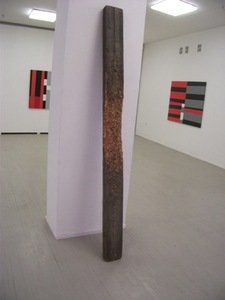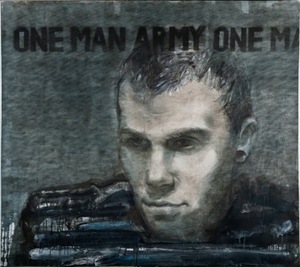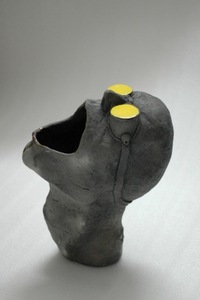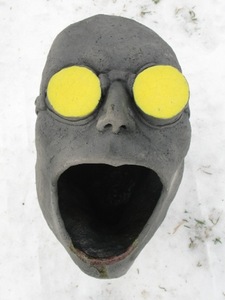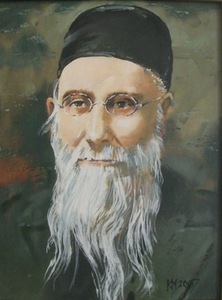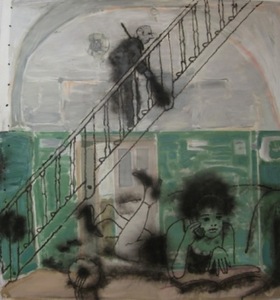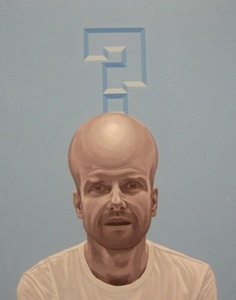THE KALEIDOSCOPE OF SHOWS IN KAUNAS 0
In brief: The painter, object and installation artist Rolandas Karalius presented his exhibition ‘Zone of Silence’ at the Meno Parkas Gallery in the beginning of March. Twelve canvases, a log marked with signs of axe and a black and white video film are shown in the display. According to the author, the works are inspired by a simple being, its contemplation and discovery that there is a silent gap between a sound and an incident.
Rhythm is highly important in this space of art objects: the rhythm of sound in the film and the rhythm of colour planes in the paintings. Another link between the works is the act of control. In his video the artist is shown chopping branches of trees, while in the canvases he fights the dynamic nature of colours. R. Karalius contains the bright colours in correct geometric forms yet they remain painfully screaming and signalling as a traffic-light.
The show is a gap between a sound and an incident. What kind of incident? The one that connects us with a work of art: flirtation or conflict, rejection or recognition of value.
***
The project ‘Duets’, continued by the Aukso Pjūvis Gallery, discusses serious topics by representing two painters – Aušra Barzdukaitė-Vaitkūnienė and Elena Balsiukaitė-Brazdžiūnienė.
A. Barzdukaitė-Vaitkūnienė reflects her contemplations about social margins and human flaws. The line, which captures figures and traits of her characters, dominates in the plane of pictures; only the most necessary colours and tints are left. The artist depicts people who are not able to cope with the issues of alcoholism and those pushed into the margins of society.
E. Balsiukaitė-Brazdžiūnienė opens the door into the world of children in her photography series ‘Homo Ludens Forever’ and painting series ‘Complex of Hamlet’. In her photographs, the artist shows moments from a kindergarten in Porto (Portugal). The author draws attention to the rules created and changed during a children’s game: roles are being set and life is being rehearsed. Adolescence becomes the centre of attention in her paintings; the painter sees every youngster as Hamlet – a young, stubborn yet fragile rebel.
***
The same gallery has started a new initiative: an original ceramics show is to be held here every month (curator – Rūta Marija Purvinaitė). In this connection the young ceramicist Andrius Janulaitis organised his first solo exhibition ‘AJ’. The artist successfully combines different materials: ceramics, natural tree branches, glass and bone. A. Janulaitis calls his sculptures ‘relics of death’. Painful moments of human existence are reflected in them variously – with the help of symbolic figures, chosen materials and deformation.
***
Another art exhibition is held at Irena Mikuličiūtė‘s Art Gallery, which represents the series of historical portraits ‘Glance at the Past’ by Artūras Slapšys.
The artist lived in Chicago in 1996-2011 and returned to Lithuania before last Christmas. The author is interested in mythology and Lithuanian history. The display shows his portraits of Lithuanian dukes, where he pays a lot of attention to the detailed depiction of clothing and weaponry.
***
A special light comes from the paintings of Kęstutis Milkevičius (1953-2009), whose exhibition is held at Kaunas Artists House. His individual style is easily recognizable because of the musicality of colours, realistic drawing, and soft modelling. The artist animates the heroes of his pictures – Jewish priests and synagogues - with a light touch. Even contemplation or worries look lucid, light and levitating. K. Milkevičius is as if a chronicler writing with sensitive accords of colours.
***
Antanas Žmuidzinavičius Museum invites to see three films of the famous Taiwanese artist Chen Chieh Jen (b. 1960). ‘Empire’s Borders I’, ‘Empire’s Borders II’ and ‘The Factory’ reveal sores of society. The artist is sensitive towards the history of Taiwan, global politics of economics and its scars left in the lives of common people. The Cold War and cheap workforce turned the country into one of the largest industrial centres in the world in the 1960’s. However, three decades later the Taiwanese industry moved to foreign countries and many people in Taiwan were left jobless.
His film ‘The Factory’ shows a group of workers from the Lien Fu clothing factory, which was closed in 1990’s. The artist combines fragments of working women’s movements, images of protest and archival material from the 1960’s, when the Taiwanese industry lived its Golden Age.
‘Empire’s Borders I’ reveals the misuse of consulate officers during the American visa interviews with the Taiwanese citizens. In the second film the artist creates the picture of the Cold War period based on his father’s experience, his documents and stuff.
***
Three artists - Paweł Łubowski (Poland), Kaido Ole (Estonia) and Jonas Gasiūnas (Lithuania) – represent tendencies of contemporary painting at Kaunas Picture Gallery. The second show from the series ‘Three Lessons of Painting’ is called ‘New Conceptual Painting’.
P. Łubowski presents video and installation work together with his paintings.
K. Ole creates the impression of weightlessness in infinite space in his series ‘Kaido Looking for a Proper Place’. Humour and healthy self-irony can be felt in his works, especially in the series ‘Kaido Thinking’.
J. Gasiūnas keeps on using his original technique – drawing with smoke. His distinctive works fuse into the entity, which is full of irony for history and the present.








